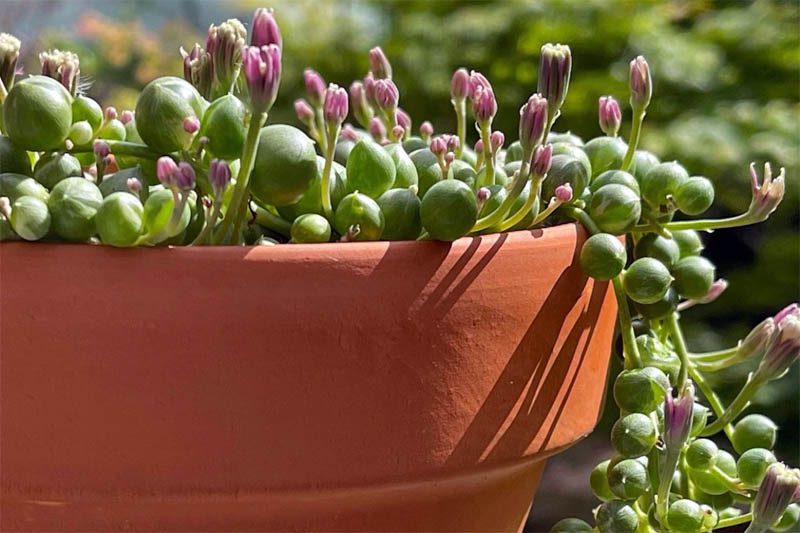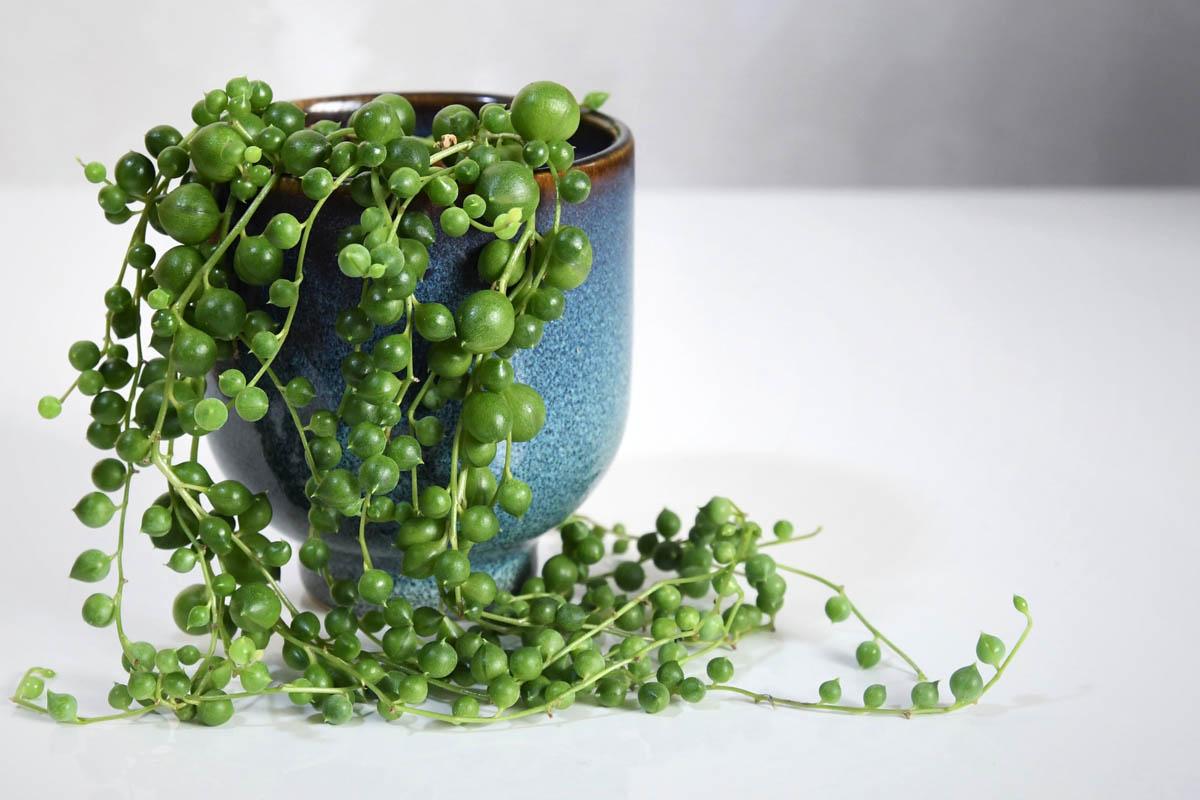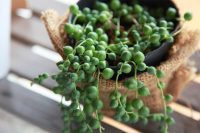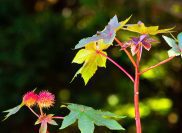Is string of pearls toxic to dogs? Ι What is string of pearls? Ι Toxicity Ι How toxic is string of pearls Ι Clinical signs Ι Treatment Ι Prevention Ι Conclusion
Is string of pearls toxic to dogs?
String of pearls (Curio rowleyanus) is toxic to dogs, cats and humans. The toxic principles are an irritant sap and pyrrolizidine alkaloids, a plant toxin that inhibits cell division primarily in the liver which can lead to acute liver failure.
What is string of pearls?
| Family | Asteraceae |
| Botanical name | Curio rowleyanus, formerly known as Senecio rowleyanus |
| Common names | String of Pearls, String of Beads, Rosary Vine |
| Plant type | Succulent |
| Flower colour | White |
| Native to | Southwest Africa |
| Toxic property | Pyrrolizidine alkaloids, irritant sap |
| Toxic parts | All parts |
| Severity | Moderate |
String of pearls (Curio rowleyanus) is a creeping perennial succulent native to southwest Africa. Its long stems contain pearl-shaped leaves which make it an attractive and unique houseplant for hanging baskets. Under the right conditions, a healthy string of pearls can grow up to 4 feet long and will produce beautiful cinnamon-scented white flowers with purple tips.
The round ‘pearls’ are actually modified leaves, their shape is designed to store water, which can then be used in times of drought. Growers may notice the leaves shrivel up if the plant dries out. Once they have been watered they plump up again. Each leaf has a small transparent area known as the epidermal window, its function is to maximise photosynthesis by allowing light to penetrate the inside of the leaf.
String of pearls has a shallow root system, reaching a depth of 1 – 2 cm. This makes string of pearls well-suited to grow in shallow containers or hanging baskets as the roots can adapt to limited soil space. In addition to the the normal root system, string of pearls has adventitious roots, which means they can grow from other parts of the plant, usually the stem. This allows the plant to put out new roots any time the stem is in contact with the soil and anchor the plant to the ground.
String of pearls also grows in a variegated form (Senecio rowleyanus f. variegatus), which is made up of mostly green leaves, with areas of white (variegation).

Related plants:
- C. radicans – String of bananas, String of beans
- C. peregrinus – String of dolphins
- C.herreianus – String of watermelons, String of beads, String of raindrops
- C. citriformis – String of tears
The string of pearls plant was named after British botanist, Gordon Douglas Rowley who specialised in succulents and cacti. This can be a tricky and frustrating plant to keep alive to many plant lovers. Choose a well-draining, sandy soil, string of pearls doesn’t like its roots sitting in soggy soil. As a succulent, it is drought tolerant and should only be watered when the soil is dry. String of pearls has lower light requirements than other succulents, mine are in an east-facing position (Australia), and receive morning sun.
Propagating string of pearls is simple, just snip the stem just above a node, and dip the cut end in rooting powder. Make a 2.5 cm (1 inch) hole in the potting mix to place the cutting in. Press down to secure. I have found layering propagation more effective than sticking multiple cuttings into one pot. You’re using one or two single stems and allowing them to establish a strong root system as each part of the stem is able to lay down roots. To layer, dip the snipped end into the soil, and coil the remainder of the cutting around the top layer of soil. Gently press in so that the stem is in contact with the soil.
Toxicity
The toxic principles of string of pearls are pyrrolizidine alkaloids (PAs) which can cause gastrointestinal upset and dermatitis from the irritant sap which is released when the plant is damaged or cut.
Dogs do not know if a plant is toxic or not, and therefore it is important to be aware of the potential dangers. Puppies are at increased risk due to their curious nature. As the owner of an eight-week-old puppy, I have watched her explore her world with her mouth, including a range of plants, while my adult dog tends to snack on grass, but has no interest in other plants.
Toxicity class: The University of California classifies the toxicity class of Senecio spp. as 2 and 4.
2) Minor Toxicity: Ingestion of these plants may cause minor illnesses such as vomiting or diarrhea. If ingested, call the Poison Control Center or your doctor.
4) Dermatitis: The juice, sap, or thorns of these plants may cause a skin rash or irritation. Wash the affected area of skin with soap and water as soon as possible after contact. The rashes may be very serious and painful. Call the Poison Control Center or your doctor if symptoms appear following contact with the plants.
How toxic is string of pearls?
The severity of the toxicity of string of pearls can vary depending on a number of factors, including the amount of plant material ingested, the size and health of the pet, and the speed of treatment following ingestion. It’s important to seek veterinary attention immediately if you suspect that your pet has ingested any part of the string of pearls plant.
Clinical signs
Symptoms may relate to localised skin irritation, gastrointestinal disorders and liver failure if the dog has ingested a large quantity of string of pearls.
Gastrointestinal
- Abdominal pain
- Loss of appetite
- Drooling
- Vomiting
- Diarrhea
Dermal
- Mild skin irritation (redness) or rash
Liver
- Jaundice (yellowing of the gums and the whites of the eyes)
- Neurological changes
- Vomiting
- Diarrhea (which may contain blood)
- Seizures
What should I do if my dog ate string of pearls?
If your dog has ingested string of pearls, it is important to take immediate action to minimise the potential harm to your pet.
- Carefully remove any remaining plant matter from the dog’s mouth to prevent further ingestion.
- Contact your veterinarian or a pet poison helpline immediately and let them know the pet has ingested string of pearls. The veterinarian may recommend a wait-and-see approach if the dog is not displaying symptoms.
- Keep a close eye on your cat for any signs of gastrointestinal distress, such as vomiting or diarrhea, as well as any other unusual symptoms such as lethargy, tremors, or seizures. These symptoms may not appear immediately, so it’s important to monitor your cat closely for at least 24-48 hours after ingestion.
Treatment
Seek immediate veterinary attention if your dog has consumed any part of string of pearls or related Senecio species.
If ingestion was recent, the veterinarian can induce vomiting or flush the stomach (gastric lavage) to empty the contents. Activated charcoal will be administered as a follow-up to bind to any remaining plant matter.
Intravenous fluids will be administered to treat or prevent dehydration and electrolyte derangements and help flush any remaining toxins from the system.
Supportive care may include anti-nausea medications, vitamin K (a fat-soluble vitamin needed for the formation of certain clotting factors, as the liver fails, clotting factors decrease, which can lead to blood clotting disorders), and plasma transfusion for dogs who have developed blood clotting disorders.
Prevention
Pet owners must be aware of the potential dangers of houseplants which includes keeping toxic plants out of reach of pets, supervising pets when they are near plants and seeking immediate veterinary care if you suspect your pet has ingested a toxic plant.
- Know which plants are toxic to pets and always research the toxicity of plants before bringing them into your home or garden.
- If you have a puppy or dog prone to chewing, provide safe alternatives such as bully sticks or Kong toys.
- Keep toxic plants, including string of pearls, out of reach of pets. Place plants on high shelves or use hanging baskets to keep them away from your dog.
- Use barriers such as baby gates to keep dogs out of areas with toxic plants.
- Avoid using toxic fertilisers or pesticides around plants that your dog may have access to.
- Grow pet-safe plants instead such as spider plants, bamboo, peperomia, golden cane palm, ponytail palm, golden cane palm and Boston fern.
Conclusion
- String of pearls is considered toxic to dogs due to the presence of glycosides, which can cause a range of adverse effects when ingested.
- Symptoms of toxicity can include vomiting, diarrhea, lethargy, dehydration, tremors, seizures, and even death in severe cases.
- The severity of the toxicity can vary depending on factors such as the amount ingested as well as the size and health of the dog.
- Pet owners can take steps to prevent poisoning by keeping string of pearls and other potentially harmful plants out of reach of their pets, and by seeking veterinary attention immediately if ingestion is suspected.
Julia is a writer and landscape consultant from Wollongong with a love of horticulture. She had been an avid gardener for over 30 years, collects rare variegated plants and is a home orchardist. Julia is passionate about learning and sharing her knowledge of plant propagation and plant toxicology. Whether it’s giving advice on landscape projects or sharing tips on growing, Julia enjoys helping people make their gardens flourish.




